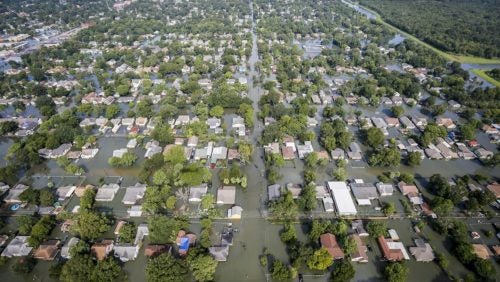Houston at a Crossroads: Land Use Post-Harvey
October 17, 2018 by Cecilia Turchetti

Houston in the aftermath of Hurricane Harvey
In the wake of Hurricane Harvey, Houston has continued to develop at an incredible rate. Historically, the city and its residents have strongly opposed zoning, but development in floodplains has sparked a debate about how expansion should look for the booming city. How can Houston continue to grow while ensuring the safety of its residents?
Houston’s lack of zoning laws[1] is almost as representative of the city as chopped n’ screwed music and 83” elbows on glossy Cadillacs. As a result, a drive through the city will find skyscrapers next to residential neighborhoods, highways above bayous, and apartments squished between drive-through fast food chains.[2] You name the combination, somewhere in Houston, it probably can be found. Residents have voted against zoning plans three times in the last century.[3] Houstonians oppose additional government restrictions to land use for a number of reasons. Some believe it restricts private property rights, others believe it creates segregated neighborhoods, and others believe the market regulates itself because “a developer does not want to build a single family house next to an industrial facility.”[4]
Despite Houston’s prideful label as “the city with no limits,”[5] since Harvey wreaked havoc there have been increased calls to regulate development in order to protect the city from another disaster. In the past 20 years, Houston has seen a surge of development[6] and with it came a massive increase in impervious surfaces.[7] Impervious surfaces such as asphalt roads, concrete, and brick walkways do not absorb water like natural ground cover.[8] This lack of absorption leads to greatly increased stormwater runoff.[9] Storm water runoff causes rapidly-moving water to rush through the streets.[10] As a result, during storms such as Harvey, the water cannot soak into the ground as it did when the land was forested.[11] Instead, the land floods. The stormwater winds up in surrounding bodies of water, causes erosion and habitat destruction, and carries many pollutants.[12]
Earlier this year, the Houston City Council unanimously voted to approve the development of hundreds of homes in west Houston by Meritage Homes.[13] Although city officials claimed the developer’s plans met recently-passed stricter standards for development— requiring homes to be built at least two feet above the floodplain—the fact remains that the land is a floodplain, and the people who live near those areas are consistently at risk of flooding.[14] This decision was taken despite the city buying up homes due to flood risks.[15] It was also passed without notifying members of the Harris County Flood Control District, and despite concerns by residents and environmentalists.[16] Jim Blackburn, an environmental lawyer and co-director of the Severe Storm Center at Rice University said of floodplains: “[W]e treat them as an impediment to development that we can just design through, and we ought to be staying out of the [floodplains].”
Houston is at a crossroads. Doing nothing is not an option, and attitudes need to change. Hurricane Harvey displaced around 34,575 people from their homes.[17] By December 5, 2017, 623,388 individuals or households just in metro Houston had submitted valid registrations for FEMA’s Individuals and Households Program (IHP).[18] It is possible to enact stricter regulation for floodplain development to decrease storm runoff without sacrificing Houston’s unique zoning wonderland.[19] Houston has a unique opportunity to demonstrate that lack of zoning truly is an asset. It can leverage its lack of zoning to increase population density in historically safe parts of town and make stronger efforts to regulate development in flood plains.[20]
[1] Letter from Sylvester Turner, Mayor, Hous., TX (Jan. 1, 2018), http://www.houstontx.gov/planning/Forms/devregs/2018_no_zoning_letter.pdf.
[2] Fernando Ramirez, The Weirdest Images to come from Houston’s Lack of Zoning Laws, Hous. Chronicle (August 17, 2018, 8:09 am), https://www.chron.com/news/houston-texas/houston/article/Weirdest-images-from-Houston-s-lack-of-zoning-laws-9171688.php#photo-10795066.
[3] Lydia DePillis, Character Builder: Houston’s Zoning Battles, Hous. Chronicle (July 6, 2016, 10:04 am), https://www.chron.com/local/history/economy-business/article/Character-builder-Houston-s-zoning-battles-8342526.php (“Houston remains the only major city without a zoning ordinance . . . despite three major attempts over the past century to bring it in line with the rest of urban America.”).
[4] Ramirez, supra note 1.
[5] Houston: The City with No Limits, https://www.thecitywithnolimits.com/ (last visited September 29, 2018).
[6] Population Report- January 2017, Harris Cty. Budget Mgmt. Dep’t. 4 (Jan. 2017), http://budget.harriscountytx.gov/doc/Budget/fy2018/reports/FY18_Population_Report.pdf (“[T]he number of single family homes in Harris County has grown by 20% since 2006”).
[7] Kim McGuire, Houston’s Development Boom and reduction of wetlands leave region flood prone, Hous. Chronicle (last updated July 25, 2016, 9:58am), https://www.houstonchronicle.com/news/houston-texas/houston/article/Houston-s-development-boom-and-reduction-of-8403838.php (“Between 2001 and 2011, Fort Bend County . . . had a 53 percent increase in impervious surfaces . . . . ”).
[8] Trees and Stormwater Runoff, Ctr. for Watershed Prot.,
https://www.cwp.org/reducing-stormwater-runoff/ (last visited September 28, 2018).
[9] Id.
[10] Id. (“[L]arge volumes of water are swiftly carried to our local streams, lakes, wetlands and rivers and can cause flooding and erosion . . . Stormwater runoff also picks up and carries with it many different pollutants that are found on paved surfaces such as sediment, nitrogen, phosphorus, bacteria, oil and grease, trash, pesticides and metals.”).
[11] Id.
[12] Id.
[13] Rose-Ann Aragon, City says Housing Development in West Houston Meets New Floodplain Standards, Click2Houston, https://www.click2houston.com/news/city-says-new-house-construction-in-west-houston-meets-new-floodplain-standards (last updated April 26, 2018, 6:52pm).
[14] See Aragon, supra note 13; Mark Collette & Matt Dempsey, What’s in Houston’s Worst Flood-zones? Development worth $13.5 billion, Hous. Chronicle (December 13, 2017), https://www.houstonchronicle.com/news/houston-texas/houston/article/What-s-in-a-floodway-In-Houston-20-000-12409821.php (paraphrasing Matthew Zeve, director of operations for the Harris County Flood Control District, “he wishes MetroNational, which sold the land to the developers, would have offered to sell it to the flood control district. MetroNational said the district never raised the idea.”).
[15] Aragon, supra note 13.
[16] See id. (quoting the Harris County Flood Control District and a member of Residents Against Flooding about flooding concerns).
[17] Houston in Perspective, Greater Hous. P’ship (March 19, 2018), http://www.houston.org/pdf/comm/Hurricane-Harvey-Statistics.pdf.
[18] Id.
[19] See Nolan Gray, How Urbanism Can Help Houston Recover from Hurricane Harvey, Pac. Standard (January 5, 2018), https://psmag.com/economics/houston-needs-to-build-up-not-out.
[20] Id.

